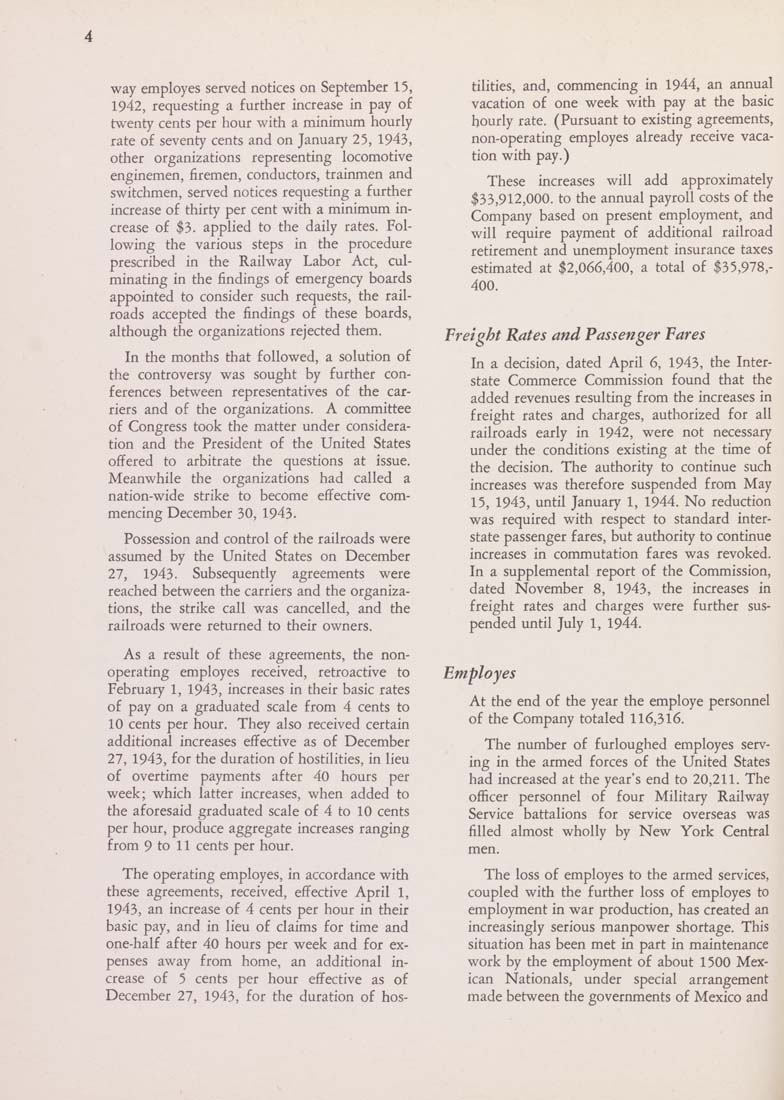way employes served notices on September 15,
1942, requesting a further increase in pay of
twenty cents per hour with a minimum hourly
rate of seventy cents and on January 25, 1943,
other organizations representing locomotive
enginemen, firemen, conductors, trainmen and
switchmen, served notices requesting a further
increase of thirty per cent with a minimum in¬
crease of $3. applied to the daily rates. Fol¬
lowing the various steps in the procedure
prescribed in the Railway Labor Act, cul¬
minating in the findings of emergency boards
appointed to consider such requests, the rail¬
roads accepted the findings of these boards,
although the organizations rejected them.
In the months that followed, a solution of
the controversy was sought by further con¬
ferences between representatives of the car¬
riers and of the organizations. A committee
of Congress took the matter under considera¬
tion and the President of the United States
offered to arbitrate the questions at issue.
Meanwhile the organizations had called a
nation-wide strike to become effective com¬
mencing December 30, 1943.
Possession and control of the railroads were
assumed by the United States on December
27, 1943. Subsequently agreements were
reached between the carriers and the organiza¬
tions, the strike call was cancelled, and the
railroads were returned to their owners.
As a result of these agreements, the non-
operating employes received, retroactive to
February 1, 1943, increases in their basic rates
of pay on a graduated scale from 4 cents to
10 cents per hour. They also received certain
additional increases effective as of December
27, 1943, for the duration of hostilities, in lieu
of overtime payments after 40 hours per
week; which latter increases, when added to
the aforesaid graduated scale of 4 to 10 cents
per hour, produce aggregate increases ranging
from 9 to 11 cents per hour.
The operating employes, in accordance with
these agreements, received, effective April 1,
1943, an increase of 4 cents per hour in their
basic pay, and in lieu of claims for time and
one-half after 40 hours per week and for ex¬
penses away from home, an additional in¬
crease of 5 cents per hour effective as of
December 27, 1943, for the duration of hos¬
tilities, and, commencing in 1944, an annual
vacation of one week with pay at the basic
hourly rate. (Pursuant to existing agreements,
non-operating employes already receive vaca¬
tion with pay.)
These increases will add approximately
$33,912,000. to the annual payroll costs of the
Company based on present employment, and
will require payment of additional railroad
retirement and unemployment insurance taxes
estimated at $2,066,400, a total of $35,978,-
400.
Freight Rates and Passenger Fares
In a decision, dated April 6, 1943, the Inter¬
state Commerce Commission found that the
added revenues resulting from the increases in
freight rates and charges, authorized for all
railroads early in 1942, were not necessary
under the conditions existing at the time of
the decision. The authority to continue such
increases was therefore suspended from May
15, 1943, until January 1, 1944. No reduction
was required with respect to standard inter¬
state passenger fares, but authority to continue
increases in commutation fares was revoked.
In a supplemental report of the Commission,
dated November 8, 1943, the increases in
freight rates and charges were further sus¬
pended until July 1, 1944.
Employes
At the end of the year the employe personnel
of the Company totaled 116,316.
The number of furloughed employes serv¬
ing in the armed forces of the United States
had increased at the year's end to 20,211. The
officer personnel of four Military Railway
Service battalions for service overseas was
filled almost wholly by New York Central
men.
The loss of employes to the armed services,
coupled with the further loss of employes to
employment in war production, has created an
increasingly serious manpower shortage. This
situation has been met in part in maintenance
work by the employment of about 1500 Mex¬
ican Nationals, under special arrangement
made between the governments of Mexico and
|








